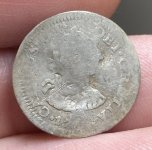Carl-NC
Bronze Member
- Mar 19, 2003
- 1,871
- 1,359
- Detector(s) used
- Custom Designs and Prototypes
- Primary Interest:
- All Treasure Hunting
I have a Minolta 7D, and a Meade LX200. Thinking about using the Minolta on the Meade, and buying a newer Sony for regular photography. I haven't priced IR cameras in a while, so maybe the prices have come down. No, they won't find gold, but at least when you discover that fact you will be left holding a camera which is worth something.


 ?
?

